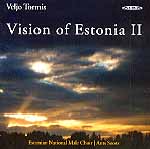To save repeating myself, I refer you to my review of the earlier Vision of Estonia I, which essentially describes Veljo Tormis’ male choir music–its style and thematic foundations–as well as the formidable performing abilities of the Estonian National Male Choir and its outstanding conductor Ants Soots (for the review, type Q4756 in Search Reviews). The works presented here are primarily focused on Tormis’ deeply felt convictions regarding war and its tragic effects, and as usual are centered in Estonian life and experience. The texts and thematic material comes from folklore, from the Estonian national epic Kalevipoeg, and from Soviet-era literary sources well-known to the Estonian people. These a cappella pieces (some with added percussion or certain singer-produced percussive effects) are relentless in their dramatic power, and the vocal demands–harmonically, rhythmically, and in sheer range of expression–require individual singers of supreme skill. The performances profoundly benefit from an ensemble that’s fully immersed in the composer’s style and born to the Estonian language and national idioms.
Of course, there’s no question that all of those ingredients are in place here–you’ll hear it from the opening “shouts” from the chorus in The Ballad of Mary’s Land, a vigorous, multilayered tour de force that sets the stage for even more astonishing, unusual, and unexpected experiences to come. Among the “war” pieces, God Protect Us from War is notable for its lively rhythmic chanting accompanied by occasional emphatic whip-cracks. Perhaps most unusual is the “documentary cantata” Voices from Tammsaare’s Herdboy Days, its subject taken from a famous novel about Estonian life, its music designed to reflect sounds from the novelist’s boyhood. Besides the male choir (singing various folksongs) and percussion (including various types of bells), we hear a superimposed “phonogram” recording of a woman (Tammsaare’s sister, it turns out) singing a simple folk tune. Days of Outlawry concerns resistance to occupation, a sensitive issue during the Soviet era–the film this music was written for was banned.
Although Tormis remains in the tonal realm, he manages to make us forget about such things; they don’t really matter here because he so effectively focuses our attention on the texts, the atmosphere, the emotions of each work–and none of these elements is ever far from the storm-tossed surface. No, there’s not much subtlety, there aren’t many idyllic scenes nor “life is wonderful” themes. Instead, we’re kept on the edge of our seats by strong and ever-changing rhythmic structures, striking textural effects–from closely-packed to wide-open voicings, vocal percussive interjections, and even variations of tone quality. This latter is especially notable in the program’s final set of Men’s Songs, which also display generous amounts of humor and earthy expression. This is a fabulous recording in ideal sound–essential listening. And if you missed Volume 1, don’t delay. [8/27/2004]
































